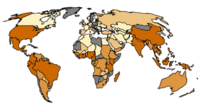SOCR Data 2008 World CountriesRankings
From Socr
Contents |
SOCR Data - Ranking of the top 100 Countries based on Political, Economic, Health, and Quality-of-Life Factors
Data Description
Overview ...
- Source: [1].
- Variables
- Income Groups: All countries are divided into income groups according to their gross and per capita 2009 gross national income (GNI), see World Bank Atlas.
- Population Groups: The population size of the Country is a categorical label: large > 50 million; 20 < medium < 50 million and small < 20 million.
- Education: Combined universal score on TIMSS and PISA tests using Jamison, Jamison and Hanushek's normalization technique. If schools did not administer these tests, an achievement score was imputed by doing a regression of literacy rate (CIA World Factbook) and average years of schooling against the universal score.
- Health: Healthy life expectancy in years (at time of birth). This represents the average number of years that a person in this country is expected to live, accounting for years lived in in disease and/or injury (World Health Organization).
- Quality of Life: a multivariate measure of the quality of life depending on:
- Inequality measure: Gini coefficient measuring the degree of inequality in family income (UNDP).
- Gender Gap: the degree of economic, health, education and political inequality between the sexes ([ http://www.weforum.org/en/initiatives/gcp/Gender%20Gap/index.htm World Economic Forum, Gender Gap]).
- Extreme poverty: percent of the population living on less than $2/day (World Bank).
- Standard of living: Consumption per capita - private consumption divided by population (Global Insight).
- Homicide rate: Homicides per 100,000 population (UN Office on Drugs and Crime).
- Environmental Health: air/water pollution and environmental burden of disease on humans (Yale’s Environmental Performance Index).
- Unemployment rate: percentage of labor force without jobs (CIA World Fact Book).
- Economic Dynamism: measure of the country's economic conditions.
- Growth in GDP/capita: purchasing power parity multiplied by the average of the GDP per Capita growth rate over the last ten years and the GDP per Capita growth rate over the next ten years (World Fact Book). Expressed in incremental US$ of growth per person.
- Diversification: Services and Manufacturing as percentage of GDP (World Bank, Global Insight).
- Innovation: according to the World Economic Forum’s Innovation Index. Innovation is based on capacity for innovation, quality of scientific research, company spending on R&D, university-industry collaboration in R&D, government procurement of advanced technology products, availability of scientists and engineers, utility patents, intellectual property protection (WEF Global Competitiveness Report).
- Business vitality: a measure of ease of doing business. It ranks economies on regulatory environment’s conduciveness to business operation. The index ranks the simple average of the country's percentile rankings on 10 topics covered in Doing Business 2007: How to reform; ranking on each topic is the simple average of the percentile rankings on its component indicators.
- Bankruptcy: the number of years from the filing for insolvency in court until the resolution of distressed assets (World Bank).
- Time to start a new business: the number of calendar days needed to complete the procedures to legally operate a business (World Bank).
- Stock market capitalization: The stock market capitalization as percentage of GDP: equity market capitalization of domestic companies listed on domestic and international exchanges as a percentage of GDP (S&P and McKinsey Global Institute).
- Political Environment: a measure of the freedom and stability of the country's political system.
- Freedom House Rating: A measure based on electoral process, political participation, functioning government, freedom of expression and belief, associational and organizational rights, rule of law, and personal autonomy and individual rights.
- Global Peace Index’s Political Participation rating: A qualitative assessment of voter participation/turn-out for national elections, citizens engagement with politics (EIU Democracy Index).
- Political Risk Service's Political Stability rating: An independent rating of political risk faced by governments, corporations and investors (Political Risk Services).
- Political Environment: a measure of the freedom and stability of the country's political system.
Data
References
- Newsweek's Methodology, Country Ranking and Supporting Article.
- XML Data and XML Metadata.
- SOCR Home page: http://www.socr.ucla.edu
Translate this page:

